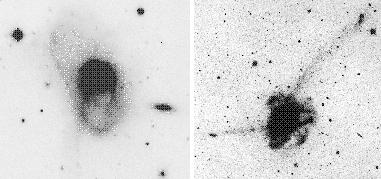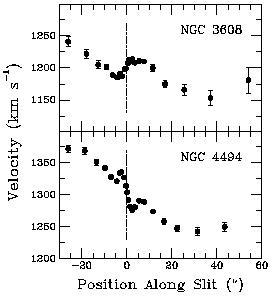


The notion that galaxy collisions are highly inelastic (Alladin 1965) and lead - via dynamical friction and orbital decay - to mergers (TT) is now well supported by both N-body simulations and observations (e.g. Barnes 1998). Major mergers clearly do wreck disks and can form giant ellipticals, as first proposed by TT. What remains controversial is whether most ellipticals formed in this manner, and whether those in clusters formed in a systematically different way from those in the field. As described below, there is growing evidence that most giant ellipticals did indeed form through major mergers, and that this occurred earlier on average in clusters than in the field.

|
Figure 3. Two recent merger remnants NGC 3921 (left) and NGC 7252 (right) with properties marking them as present-day protoellipticals (from Schweizer 1996, 1982). |
First, the evidence is strong that remnants of recent equal-disk
mergers are present-day protoellipticals. The main theoretical advance
has been the inclusion of dark-matter halos and gas in the
N-body simulations, leading to efficient mechanisms for outward
angular-momentum transport and central density increases
(Barnes 1988;
Barnes & Hernquist
1996).
The model remnants are generally triaxial,
violently but incompletely relaxed, and lack rotational support.
Their projected isophotes - determined mainly by the inclinations of
the progenitor disks and the viewing geometry - can range
from boxy through boxy-and-disky to rather strongly disky, as
observed in real E and E/S0 galaxies
(Barnes 1992;
Heyl et al. 1994).
Observationally, recent merger remnants such as NGC 3921 and NGC 7252
(fig. 3)
feature pairs of tidal tails but single main bodies with relaxed,
r1/4-type light distributions
(Schweizer 1982,
1996;
Stanford &
Bushouse 1991).
Their power-law cores, central luminosity densities,
velocity dispersions, and radial color gradients are typical of giant
ellipticals
(Lake & Dressler
1986;
Doyon et al. 1994).
Major starbursts,
reflected in the integrated-light spectra and in major populations of
young star clusters, seem to have converted 10%-30% of the visible
mass into stars and have nearly doubled the number of globular clusters.
Therefore, in all their observed properties such remnants appear to be
 1 Gyr old protoellipticals.
1 Gyr old protoellipticals.
Second, recent remnants of disk-disk mergers display several phenomena that connect them also to much older ellipticals. Foremost among these phenomena is the return of tidally ejected material. Model simulations including the effects of massive dark halos predict that most of the matter ejected by two merging disks into tails remains bound and must eventually fall back onto the merger remnant (Barnes 1988). This infall is observed in the H I gas near the base of the tails of NGC 7252 and NGC 3921 (Hibbard et al. 1994; Hibbard & van Gorkom 1996) and is presumably shared by the stars. Interestingly, H I absorption in radio ellipticals invariably indicates gas infall (van Gorkom et al. 1989). Infalling stars also yield a natural explanation for many of the faint ripples (`shells') and plumes observed in elliptical galaxies. As dynamically cold streams of stars fall back into the remnants, they wrap around the center and form sharp-edged features at their turnaround points (Hernquist & Spergel 1992; Hibbard & Mihos 1995). The high percentage (~ 70%) of field ellipticals featuring such fine structure (Schweizer & Seitzer 1992) and the considerable amounts of material indicated by integrated photometry (Prieur 1990) suggest that most of the observed fine structure cannot be due to mere dwarf galaxies falling in. Instead, such structure is much more likely the signature of past major mergers that formed most, or even all, ellipticals.

|
Figure 4. Oddly rotating cores in two elliptical galaxies. Mean stellar velocities are shown as function of position along major axes. Note counterrotating core of NGC 3608 and corotating, but kinematically distinct core of NGC 4494 (Jedrzejewski & Schechter 1988). |
Third, various unexpected kinematic signatures in giant ellipticals
also point toward past mergers of gas-rich disks. About a quarter of
all ellipticals show oddly rotating cores, some rotating in the opposite
sense of the main body, others at right angles, and still others in the
same sense but much faster (fig. 4). When studied in
detail, such cores appear to
be small disks (r  0.2-3 kpc) indicative of gaseous dissipation
(e.g. Bender 1996;
Mehlert et
al. 1998).
A similar central disk violently
forming stars and probably fed by gas returning from the tails is observed
in the merger remnant NGC 7252
(Wang et al. 1992;
Whitmore et
al. 1993).
Model simulations of disk mergers reproduce such odd core rotations
quite naturally
(Hernquist &
Barnes 1991).
The existence of distinct
kinematic subsystems then argues against ellipticals having assembled from
many gaseous fragments and in favor of two input disks. Exactly the
same message is conveyed by the growing number of ellipticals that - like
e.g. NGC 5128
(Schiminovich et
al. 1994)
- possess two, often nearly
orthogonally rotating, H I disks. Nearly three dozen ellipticals are
now known to feature often fragmentary outer gas disks or rings whose
kinematics appears decoupled from that of the main body (van Gorkom,
private comm.). Given that the gaseous tails of the remnant NGC 7252
lie in mutually inclined planes, there is strong reason to suspect that
these much older ellipticals acquired their outer gas through disk-disk
mergers as well.
0.2-3 kpc) indicative of gaseous dissipation
(e.g. Bender 1996;
Mehlert et
al. 1998).
A similar central disk violently
forming stars and probably fed by gas returning from the tails is observed
in the merger remnant NGC 7252
(Wang et al. 1992;
Whitmore et
al. 1993).
Model simulations of disk mergers reproduce such odd core rotations
quite naturally
(Hernquist &
Barnes 1991).
The existence of distinct
kinematic subsystems then argues against ellipticals having assembled from
many gaseous fragments and in favor of two input disks. Exactly the
same message is conveyed by the growing number of ellipticals that - like
e.g. NGC 5128
(Schiminovich et
al. 1994)
- possess two, often nearly
orthogonally rotating, H I disks. Nearly three dozen ellipticals are
now known to feature often fragmentary outer gas disks or rings whose
kinematics appears decoupled from that of the main body (van Gorkom,
private comm.). Given that the gaseous tails of the remnant NGC 7252
lie in mutually inclined planes, there is strong reason to suspect that
these much older ellipticals acquired their outer gas through disk-disk
mergers as well.
Fourth, yet another connection between disk mergers and elliptical galaxies is provided by globular star clusters. Although in nearby galaxies most such clusters appear to be very old and seem to have originated in the earliest days of galaxy formation, young globulars have recently been found to form by the hundreds in the vehement starbursts induced by major mergers. Mergers like `The Antennae', NGC 3921, and NGC 7252 can apparently produce nearly as many young globular clusters as the combined number of old globulars in the component disks, thus approximately doubling the number of clusters in the process (Miller et al. 1997; Ashman & Zepf 1998). First spectroscopic evidence shows that, as one would expect, the young globulars have much higher heavy-element abundances than the old ones, being of solar `metallicity' in the case of NGC 7252 (Schweizer & Seitzer 1998). If major mergers formed most ellipticals, one would therefore expect to find bimodal abundance distributions among their globular-cluster populations (Ashman & Zepf 1992). This is exactly what has been discovered during the past few years. Hubble Space Telescope observations show that at least half of all giant ellipticals feature bimodal cluster distributions (Gebhardt & Kissler-Patig 1999; Kundu 1999). The ratio of second- to first-generation clusters seems to typically range between 0.5 and 1, and the second-generation, metal-rich clusters tend to be more concentrated toward the centers of their host galaxies, as the merger hypothesis predicted.
Bimodal globular-cluster systems, oddly rotating cores, ripples and plumes, and fast outer-halo rotation (Bridges 1999) occur not only in field ellipticals, but also in cluster ellipticals, indicating that giant ellipticals formed via major disk-disk mergers both in the field and in clusters.
Merging galaxies and recent remnants show that disk wrecking is an ongoing process. If the wrecks are mainly ellipticals, the latters' ages should vary widely. Measured UBV colors and spectral line-strength indices suggest that this is indeed the case, with ages of field ellipticals ranging between about 2 Gyr and 12 Gyr (Schweizer & Seitzer 1992; González 1993; Faber et al. 1995; Davies 1996; Trager et al. 2000). In cluster ellipticals, the colors and line strengths vary less and the inferred ages are more uniformly old (de Carvalho & Djorgovski 1992), especially near the cluster centers (Guzmán et al. 1992). These observations all agree with the notion that - on average - major mergers occurred earliest in high-density regions now at the centers of rich clusters, significantly later in cluster outskirts where galaxies are still falling in, and at the slowest rate in the field.